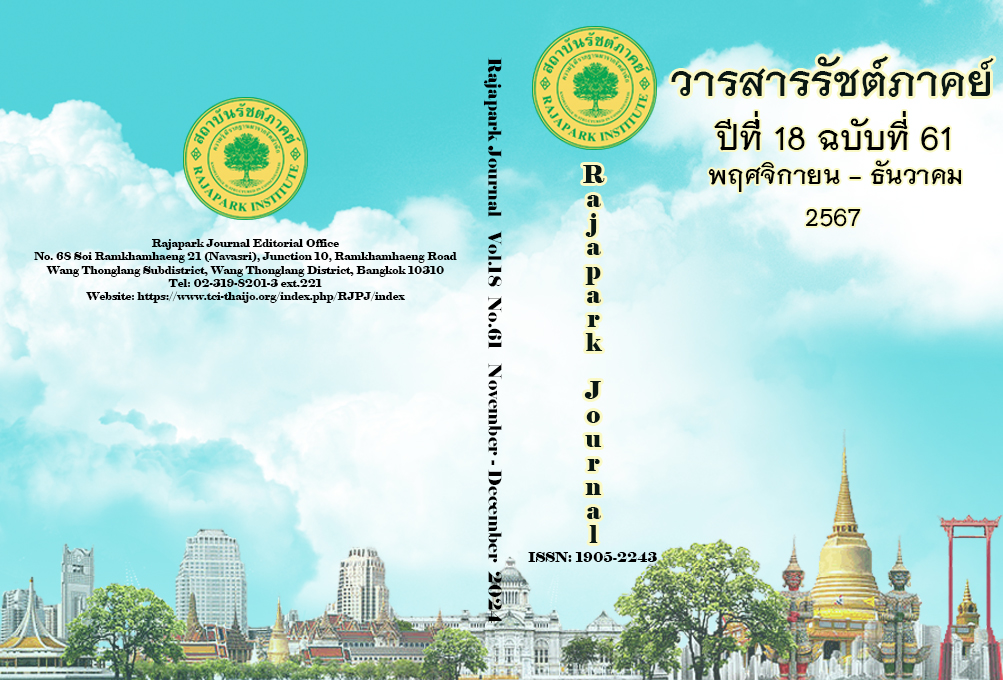The Development of Game Application on Color Theory of Art Composition for Multimedia Production Course
Main Article Content
Abstract
The objectives of this research were 1) to develop the game application on color theory of art composition for the multimedia production course, 2) to evaluate the efficiency of this game application, 3) to compare the achievement of learners before and after learning with this game application, and 4) to evaluate the learner satisfaction of this game application. The research tools were the game application for the color theory of art composition for the multimedia production course, the questionnaire for the game application quality, the pre-test and post-test, and the questionnaire for learner satisfaction. The research sample from undergraduate students majoring in multimedia technology at Nakhon Pathom Rajabhat University consisted of 50 students from 2 classes. It was selected using cluster sampling of a total of 8 classes. The game application content is related to color theory. The statistics used for data analysis were mean, standard deviation, and t-test dependent samples. The results were: 1) The assessment of the overall quality of content and production techniques was at the highest level ( = 4.58, S.D. = 0.51 and
= 4.54, S.D. = 0.51), 2) the efficiency of this game application was at 1.41 according to the Meguigans criteria, 3) the learning achievement of learners after studying was higher than before, and 4) the learner satisfaction was at the highest level (
= 4.52, S.D. = 0.50).
Article Details

This work is licensed under a Creative Commons Attribution-NonCommercial-NoDerivatives 4.0 International License.
Views and opinions appearing in the Journal it is the responsibility of the author of the article, and does not constitute the view and responsibility of the editorial team.
References
Chamnankij, S. (2022). The use of game applications for measurement and evaluation in the 21st century to improve learning achievement in the research for learning development course of bachelor of education students. Journal of education Silpakorn University, 20(1), 312-327. https://so02.tci-thaijo.org/index.php/suedujournal/article/view/251638
Damjub, W. (2019). Social media for teaching and learning in the 21st century. Journal of Liberal Arts, Maejo University, 7(2), 143-159. https://so03.tci-thaijo.org/index.php/liberalartsjournal/article/view/232338
Dampandee, K., & Mata, N. (2022). The development of game application for mathematics learning on android operating system. In The 8th National Conference on Technology and Innovation Management, NCTIM 2022, Rajabhat Maha Sarakham University, Maha Sarakham, Thailand, 18 March 2022. (pp. 1-8). http://blog.bru.ac.th/wp-content/uploads/2022/03/1646754203.pdf
Janpirom, N., Kunlaya, S., Ruengrong, P., & Kaewurai, R. (2019). Educational technology within Thailand 4.0. Panyapiwat Journal, 11(1), 304-313. https://so05.tci-thaijo.org/index.php/pimjournal/article/view/186303
Jongjitphotha, S. (2017). Color theory. SE-EDUCATION.
Karabatzaki, Z., Stathopoulou, A., Kokkalia, G., Dimitriou, E., Loukeri, P. I., Economou, A., & Drigas, A. (2018). Mobile application tools for students in secondary education. An Evaluation Study. International Journal of Interactive Mobile Technologies (iJIM), 12(2), 142-161. https://doi.org/10.3991/ijim.v12i2.8158
Ke, F. (2016). Designing and integrating purposeful learning in game play: A systematic review. Educational Technology Research and Development, 64, 219-244. https://doi.org/10.1007/s11423-015-9418-1
Leurksamutra, P., Salabsang, N., & Cheumsuk, P. (2017). Development of idiom and proverb android game application. Thonburi University Journal (Science and Technology), 1(2), 38-49. https://www.thonburi-u.ac.th/Journal_SIT/Vol1_No2_5.pdf
Meesuwan, W. (2012). Collective intelligence on social network. Journal of Education and Innovation, Naresuan University, 14(1), 90-100. https://so06.tci-thaijo.org/index.php/edujournal_nu/article/view/9412
Palachaipilomsil, S. (2011). Usages trend of mobile application. Executive Journal, 31(4), 110-115.
Poondej, C., & Lerdpornkulrat, T. (2016). Learning management with the gamification concept. Journal of Education and Innovation, Naresuan University, 18(3), 331-339. https://so06.tci-thaijo.org/index.php/edujournal_nu/article/view/66651
Prachuablarp, C. (2016). Game-based learning with development of nursing education. Journal of Nursing Division, 43(2), 127-136.
Saengrung, P., Khoonchoom, T., Seesomba, S., & Pumsanthia, U. (2022). The development of game application for learning of the adding and subtracting for 2nd grade students. Journal of Inclusive and Innovative Education, 6(1), 44-57. https://so01.tci-thaijo.org/index.php/cmujedu/article/view/245776
Sikkhabhandit, S. (1985). Educational technology. King Mongkut's University of Technology North Bangkok.
Surpare, K., & Lohakan, M. (2014). The development of application to learning on android in the subject of digital image processing for bachelor of science in technical education program. In The 7th National Conference on Technical Education. King Mongkut's University of Technology North Bangkok. November 6, 2014, (pp. 127-132).
Sookpatdhee, T., & Soranastaporn, S. (2017). Studying motion graphics media which enhanced learning ability. Journal of Humanities and Sciences Valaya Alongkorn, 12(1), 261-268. https://so06.tci-thaijo.org/index.php/vrurdihsjournal/article/view/85225
Thamteerasit, S., Phongjit, W., & Thamteerasit, A. (2022). The development of game application for enhancing the vocabulary knowledge for primary students. Journal of Social Science for Local Rajabhat Mahasarakham University, 6(1), 194-202. https://so02.tci-thaijo.org/index.php/soc-rmu/article/view/252302
Tiantong, M. (2011). Courseware design and development for CAI. King Mongkut’s University of Technology North Bangkok.
Vichitrboonyaruk, P. (2011). Social media: Future media. Executive Journal, 31(4), 99-103.
Wongyai, V., & Patphol, M. (2019). Digital learning. Curriculum and learning.
Zoe, K., & Agathi, S. (2018). Mobile application tools for students in secondary education. International Journal of Interactive Mobile Technologies, 12(2), 142-161.


